The post Undergraduate students think big with living light bulb appeared first on UBC Okanagan News.
The post Community connections improve family and child wellbeing appeared first on UBC Okanagan News.
The post An Indigenous approach to understanding water appeared first on UBC Okanagan News.
BEING A CREATIVE PROFESSIONAL IN THE FINE ARTS can be a challenging career path to navigate. For visual artist and curator Tania Willard, hearing other artists speak about their practice opened up possibilities for her own path.
“When we have an example of someone doing that in their life and the kinds of ideas they bring to their practice, it’s essential for artists to see that modelled.”
Willard started in the Bachelor of Fine Arts program at Okanagan University College (now UBC Okanagan) in 1993, and one year later transferred to the University of Victoria to complete her undergraduate degree. She then lived in the lower mainland, working as an artist and curator. Willard is of Secwepemc and settler ancestry, and returned to Neskonlith reserve near Chase, BC, with her family in 2013.
With a background as an artist and curator, Willard reconnected with UBC Okanagan when she attended the Indigenous Art Intensive as an invited artist in 2014. The intensive is an interface between local, national and international Indigenous artists, scholars and curators, as well as students and faculty at UBC Okanagan. “The intensive offers a chance to hear, learn and understand from Indigenous artist practices located here and in other places.”
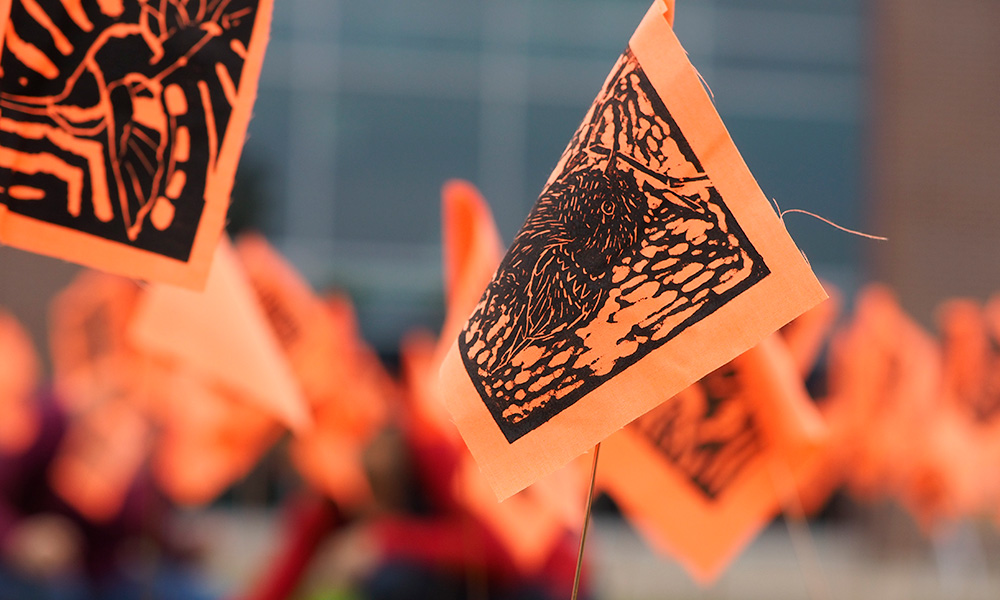
In 2022, students and faculty from UBCO came together for a series of workshops to carve a hummingbird relief print in honour of the children (little spirits) who never came home and to remember the unmarked graves at residential schools across Canada.
Willard jumped at the chance to connect with other artists visiting the area, including James Luna and Rebecca Belmore. When she started her Master of Fine Arts in 2016, Willard notes she could participate more fully with the structured courses around the Indigenous Art Intensive.
“I was fortunate to have more opportunities to connect with these artists, to collaborate and think together through different projects.”
During the 2018 intensive, Willard presented her thesis exhibition, which was an incredible opportunity for the visiting artists to see her work and give feedback on her thesis defence. As of 2019, Willard is the director of the program, as well as an Assistant Professor of Visual Arts in the Department of Creative Studies. “It seemed like a natural full circle to come back here to get my master’s and now teach.”
As part of her curatorial practice, Willard created Bush Gallery in 2013, based in her home territory. Bush Gallery provides a space for land-based ways of thinking and working, and also operates as an artist collective with other artists.
Willard points out that living on reserve the resources available are very different than in a larger centre. Through her role at UBCO, Willard has made a connection between the Bush Gallery and the Indigenous Art Intensive through her concepts of site/ation. “It was a chance to invite other artists to visit my home on reserve, and to understand those spaces and how we interact with our natural environment.”
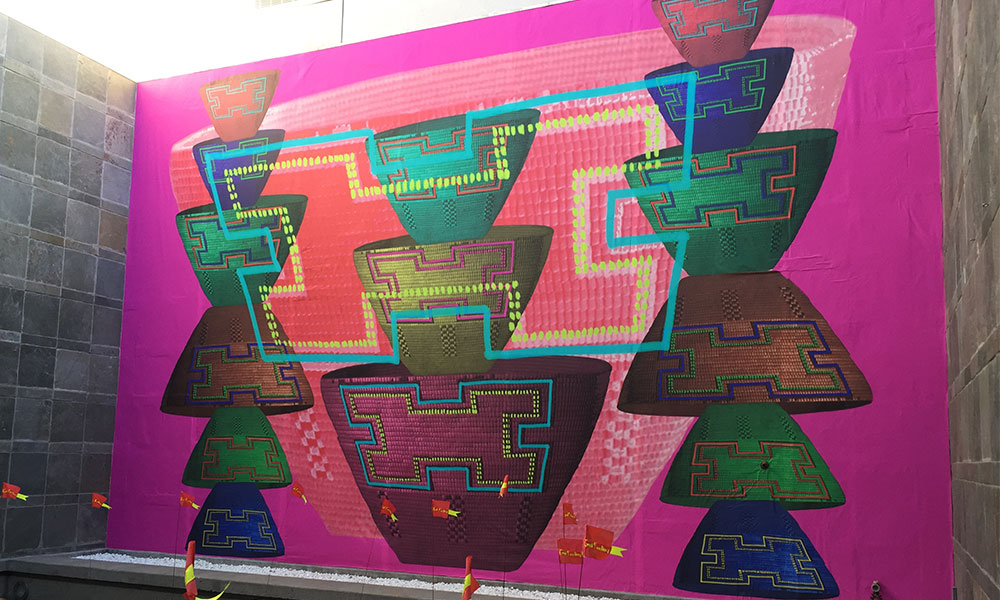
Tania Willard’s digital mural titled Gut Instincts, 2018, which she created during the Indigenous Art Intensive. Gut Instincts is an affirmation of women’s intuition, gut instinct and ancestral voices. This work takes its origin in a design from a cedar-root basket collected as part of the North Pacific Jesup Expedition (1897-1902) from Stl’atl’imx territories. As an expression of Indigenous women’s art forms, the disappearance of named makers and ancestor artists represents the colonial disappearances and dispossession of Indigenous women, communities and lands.
Site/ation studio is a research-creation space that uses collaborative creative practice as a methodology to acknowledge, advocate and advance Indigenous land-based knowledge through creative making. The Site/ation studio is supported by the Canada Foundation for Innovation, and will be located near University House on campus.
“The possibility of thinking through the land and our experiences in a gallery space continues to circulate and engage.”
Willard adds that over the last couple of years, with the COVID-19 pandemic leading to gallery closures, society has become aware of the greater need for inclusivity, diversity and representation. “We see an increase in demand for galleries to change, for collections to be accountable, and for boards to include equity, diversity and indigeneity.”
Through Willard’s work at UBCO with her students and the Indigenous Art Intensive, alongside her creative practice, she brings creative thinkers together.
“Once you get people together, you get really interesting outcomes, whether that’s exhibitions, texts, or ways it feeds into local culture and community. That’s one of the most valuable things because the unexpected happens.
“We don’t often get the opportunity to share our creativity until after school finishes, when we’re out in the world trying to make our work. This is a chance to do that in advance of starting an art career.”
The post Tania Willard is bringing creative thinkers together appeared first on UBC Okanagan News.
THE ITCHY WARMTH OF A WOOLLEN BLANKET. Birds peeping beside a trickling creek. For Dr. Fiona P. McDonald, these sensory experiences—touch, sight and sound—are important sites for her research in cultural anthropology.
Dr. McDonald, an Assistant Professor in Community, Culture and Global Studies at UBC Okanagan, followed woollen blankets on her journey to becoming a visual anthropologist. She first saw the Hudson’s Bay Company point blanket on a glass negative in the archives. Unfamiliar with these blankets, Dr. McDonald examined archives around the world and has since spent more than a decade looking at the many spaces beyond the archive where the physical woollen blankets have been moved from art galleries to museums, from sacred ceremonies to craft markets.
“This is a deeply problematic commodity that has caused intense debate and distrust,” says Dr. McDonald. “The Hudson’s Bay blankets were originally made by the Weavers of Witney in England, but the blankets became trade commodities in colonial settler spaces.”
When she traced similar woollen blankets to Aotearoa (New Zealand), she learned how Māori weavers used the red wool from blankets to replace the feathers of the now-endangered kākāpō birds that were originally used for sacred cloaks. When she was in southeast Alaska, collaborating with the Sealaska Heritage Institute, she witnessed how woollen blankets have become traditional robes in Tlingit regalia.
In her current book project, Dr. McDonald examines how Indigenous artists and makers in Canada, the United States, and New Zealand have transformed woollen blankets into anti-colonial art, craft and clan property.
Dr. McDonald’s interest in material culture extends beyond textiles to the materiality of sound and other senses. She co-founded the Collaborative + Experimental Ethnography Lab (CE2 Lab) at UBCO, a critical research lab unparalleled in Canada for sensory ethnography. The CE2 Lab is a site of collaboration between Dr. McDonald, community partners and other groups on campus.
For instance, one lab project involves sensory storytelling by creating digital tools that use art for immersive informal science learning. In a pilot project in Santa Fe, New Mexico, Dr. McDonald and her collaborator Dr. Benjamin Day Smith worked with elementary students to record sounds of water in their everyday lives. The project taught students to edit the audio they collected, and with specialized software that Dr. McDonald and Dr. Smith developed, the students created immersive sound environments.
“My priority is learning through collaboration and making room for dynamic ways of thinking with our senses, and not just about them.”
This work is part of Dr. McDonald’s larger efforts around addressing the Anthropocene in her research; she also co-published An Anthropocene Primer, a born-digital, open access publication that connects people to scholarly works, activities and knowledge across disciplines to how we think, live and understand climate justice.
Dr. McDonald is currently working with UBCO’s Dr. Jeannette Armstrong to create a new series for Nsyilxcn language works. She feels honoured to work with knowledge keepers through her research and editorial work. And this sentiment carries forward to the respect she has to live and work on unceded ancestral Syilx territory. Not only is she thrilled to bring her global experience to UBCO’s diverse campus, but the Okanagan’s access to nature is also a huge draw, allowing Dr. McDonald to snowshoe in the winter and swim in the summer. She incorporates nature into her research and teaching as well, often bringing her students to Quail Flume Trail near campus for sensory walking experiments known as anthropocenoscapes.
As an early-career researcher, Dr. McDonald’s priority is “learning through collaboration and making room for dynamic ways of thinking with our senses and not just about them.
“I model collaboration with the intention of creating a space for junior colleagues and graduate students to see and, more importantly, experience it as often as possible.”
The post Dr. Fiona P. McDonald pushes visual anthropology beyond mere images appeared first on UBC Okanagan News.
The post Opening doors for international student research appeared first on UBC Okanagan News.
What is your research focus, and why did you choose this area of study?
As a master’s student majoring in mathematics, I’m currently conducting interdisciplinary research on the intersection of machine learning and operations management. My research focuses on the applications of machine learning in service systems; particularly how textual data can be used to accurately predict customer wait times in service companies, or to improve scheduling appointments for telemedicine patients in health-care systems.
My work is driven my desire to enhance decision-making. My interest in this area stems from my curiosity about how machine learning can effectively enable service systems—and ultimately people—to make better decisions. What inspires me about this work is the potential consequences of my research on real-world problems facing both customers and business owners. In particular, our health and service systems.
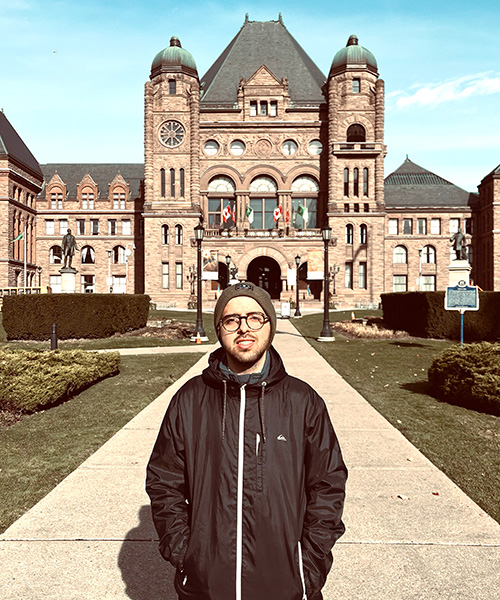
Mohammad Mosaffa.
Why is your research relevant in today’s day and age?
Using statistical approaches to devise methods to improve performance through enhancing decision-making has potential for every industry. For instance, customer service is one of several industries moving online with the rise of digitization. In this space consumers achieving prompt and effective service depends heavily on accurate wait times to achieve consumer’s expectations. My research presents an innovative strategy, which will enhance wait time estimates by combining deep learning and text mining approaches to help boost customer satisfaction and loyalty. The findings could be applied for organizations in a range of sectors, including health care and e-commerce.
What’s the best advice you have for other students?
Throughout my time in higher education, I’ve become aware of the value of effort and a drive to learn. No matter your academic standing, my best advice to other students is to never stop exploring new opportunities and taking chances.
Remember, failure should not be feared. It’s an essential step in the learning process. If we never make mistakes, we might never really understand how far we can push ourselves. To this end, I urge students to take on difficult challenges. Also, seek out a mentor or a supportive group to help you. Having a mentor with expertise in your industry can help you advance your academic and professional goals through priceless counsel and connection.
I also want to stress the value of curiosity and passion. The decision to pursue higher education can be difficult and time-consuming, so it’s crucial to pick a subject that you’re passionate about. When you’re interested in what you’re learning, the task becomes less of a chore and more of an enjoyable exploration of new ideas.
“Having benefited from mentorship myself, I’m committed to effectively training students and hope to positively influence the next generation.”
Who is your mentor and how have they influenced you?
My current mentors, Dr. Amir Ardestani-Jaafari and Dr. Javad Tavakoli, have profoundly shaped my research focus and direction. Under their guidance, I’ve been able to refine my research interests and develop a deeper understanding of the applications of machine learning in operations management. Both men have challenged me to think critically and encouraged me to explore new approaches in my research.
Beyond guiding technical aspects of my research, they have also been supportive mentors in terms of my personal and professional growth. Both professors have been helped me navigate the challenges of research and grow as a researcher. Their expertise, guidance and support have not only helped me achieve my research goals but also inspired me to excellence in my academic and professional pursuits.
What do you hope to do after graduation?
Research is a driving passion for me. Going hand-in-hand with that is my passion for teaching. Having benefited from mentorship myself, I’m committed to effectively training students and hope to positively influence the next generation. My next step is pursuing a doctorate in business with Cornell University, where I hope to achieve my goal of becoming a professor who conducts meaningful research to help improve decision-making.
The post At the intersection of mathematics and business appeared first on UBC Okanagan News.
AS A SCIENTIST, MELANIE DICKIE FIRMLY BELIEVES in the power of data to inform decisions. As a person, she enjoys spending time in the outdoors and is passionate about caring for the environment. The combination of these personal feelings and her scientific interest come together to inform her research career on the pathways that link human-caused landscape changes to caribou—a threatened species in Canada.
Dickie’s passion for preserving and restoring ecosystems in Canada’s north stemmed from fieldwork she undertook in Nunavut during her undergraduate degree.
“It was during that trip I fell in love with the idea of how humans and climate change impact ecosystems, and how these factors combine to influence the natural world we live in,” she says.
Following her undergraduate degree, Dickie completed a master’s degree at the University of Alberta and then moved into the not-for-profit sector with the Alberta Biodiversity Monitoring Institute (ABMI). At ABMI, Dickie continued to dedicate her work to providing scientifically credible information to support land use and management decisions.
“Melanie has a knack for engaging with scientists, Indigenous communities and resource managers. She has excelled at cultivating an inclusive and curious environment within her research community.”
– Dr. Adam Ford
While working at ABMI, Dickie stayed closely connected to the academic world, attending conferences and interacting with researchers on social media platforms. One researcher that she found herself interacting with often was UBC Okanagan’s Dr. Adam Ford.
“I found myself and Dr. Ford on very similar threads on social media—threads about how humans are modifying the landscape, how data is used to support transparent decision making, and the role of Indigenous communities in the management of systems,” says Dickie.
A conversation at a conference eventually led to the development of Dickie’s doctoral research at UBC Okanagan. Dr. Ford’s experience working with different ecosystems and his focus on food webs presented a new way of approaching her research.
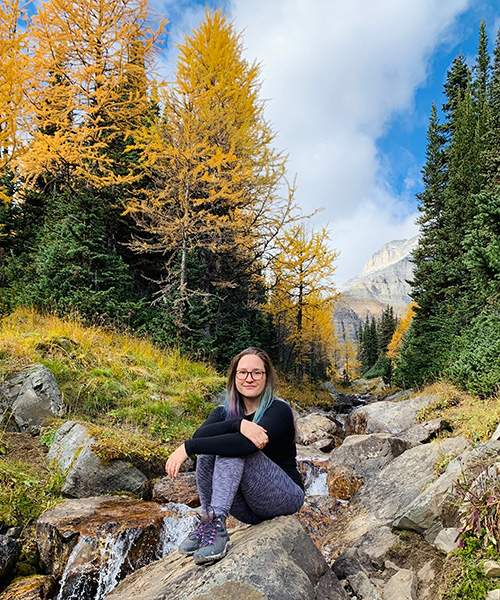
Melanie Dickie.
Dickie started her doctorate in biology at UBC Okanagan in 2020, under the supervisor of Dr. Ford in The Wildlife Restoration Ecology Lab (WiRE Lab). Through her PhD research, Dickie is exploring how human land use and climate intersect to influence the abundance of white-tailed deer. These animals are expanding deeper into caribou range where they were previously less abundant, and now act as a food source to bolster predator populations like wolves. This poses a threat to caribou, which do best in areas with low populations of predators.
Dickie’s research explores questions of what management interventions are available, how effective they are, and how they might be prioritized across the landscape to make the biggest impact for caribou. “Doing my PhD at UBC Okanagan has given me the room to push my research further,” she says. “I can research questions in broader ecological theory that can be used by decision makers.”
Dickie believes that research is about getting information to the right people and building relationships to ensure that information is used to make a difference. She hopes that her research will provide decision-makers with the tools they need to effectively manage caribou populations.
“Melanie has a knack for engaging with scientists, Indigenous communities and resource managers,” says Dr. Ford. “She has excelled at cultivating an inclusive and curious environment within her research community.”
Following the completion of her doctorate, Dickie sees herself working alongside academics, government and Indigenous communities for decades to come, continuing to reduce society’s effect on natural systems.
The post How humans and climate change affect our environment appeared first on UBC Okanagan News.
ENVIRONMENTAL ISSUES ARE USUALLY CONSIDERED SCIENTIFIC AND TECHNICAL, but they are seldom resolved in these terms alone. With an interest in contributing humanistic perspectives to global issues, Dr. Greg Garrard uses his skills in understanding other viewpoints to help bridge the distance between various disciplines, and help clarify the multiple points of view that can exist within challenging topics.
“Sometimes you need to ask different questions. And that’s the specialty of the humanities. Asking better questions,” explains Dr. Garrard. “I want to get to a place where we can understand what different groups may not be seeing so we can better work together.”
When it comes to climate change, Dr. Garrard notes that the science is known but action is missing, and that an ongoing cultural polarization—the inability to understand or communicate across differences—is a fundamental obstacle preventing that action from taking place.
As someone interested in the complexity of other humans’ perspectives, he doesn’t think of people who don’t believe in climate change as “wrong”—rather, he’s interested in their perspectives and where their opinions originate.
In the broadest sense, Dr. Garrard explores cultures of nature that include literary representations of wilderness, animals, wildfire, climate change and environmental issues. When Dr. Garrard first started in the area of environmental criticism of literature, there was no such field as ecocriticism.
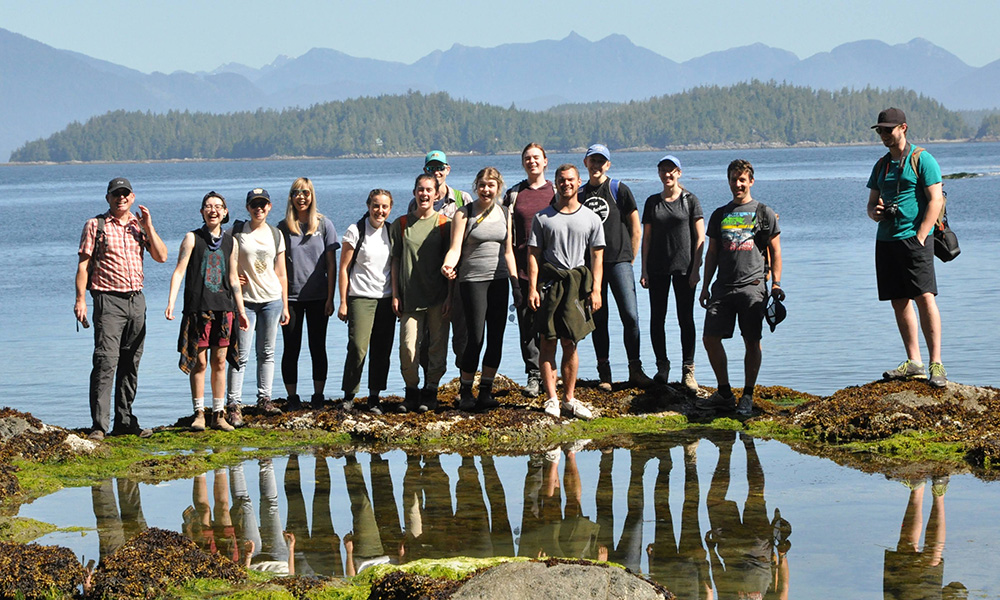
Dr. Greg Garrard (far left) with students learning in the field at the Bamfield Marine Centre. The course was called ‘In Pursuit of the Whale’ and focused on whaling literature, such as Moby Dick and A Whale for the Killing.
“As a joint honours student of philosophy and English literature, I studied environmental ethics, and I wondered if I might look to literary texts for insight into the quandaries discussed by philosophers,” he says.
Much of Dr. Garrard’s writing is in the realm of environmental literature and ecocriticism, but he is also heavily involved in working with people from other disciplines by contributing those humanistic perspectives. He helps translate between disciplines, pushing people to ask more questions and look at things from a different vantage point.
In addition to his climate change work, he’s also involved in projects like the Living with Wildfire in the BC Southern Interior research cluster with Dr. Mathieu Bourbonnais from the Department of Earth, Environmental and Geographic Sciences. Dr. Garrard feels that he and his students help bring the whole research group together, both organizationally and conceptually.
“It’s really important to be able to develop something so interdisciplinary in the digital and public humanities as a way to be involved in, and make a difference in, an area like fire research,” says Dr. Garrard.
In 2020, Dr. Garrard was awarded Social Sciences and Humanities Research Council Insight funding to support “Kelownafornia”, the next phase in his research trajectory. This ambitious multi-disciplinary study of culture-nature interactions in the United States and Canada—specifically the Okanagan Valley—overlaps with the Living with Wildfire collaboration. Both projects are working with Indigenous partners to consider how culture and nature are interacting with each other in order to help address the ongoing wildfire challenges in the BC Interior.
While scientific aspects of climate change are well understood, this hasn’t yielded the kind of concerted political and social response that scientists might have hoped for. The Okanagan Valley is experiencing immense pressure from property development and agriculture, and this will only intensify as the population grows and the climate warms over the coming decades. The Kelownafornia project aims to improve citizens’ understanding of where they live, and to highlight the gap between the idyll and the biological and climatic reality.
“We hope the project will increase support for measures to enhance the environmental sustainability of our communities here in the valley for the future,” Dr. Garrard says.
In recognition of his ongoing work exploring how culture and nature interact, and his efforts to help people communicate and understand across their differences, Dr. Garrard was named UBC Okanagan’s 2023 Researcher of the Year for the Social Sciences and Humanities.
Bringing clarity to complex situations, he says, is always a great reward.
“As a literary critic, I feel empowered helping other disciplines understand what they don’t know, what they can’t know or what they aren’t able to see.”
The post A humanist’s perspective on our environment appeared first on UBC Okanagan News.
DESPITE DECADES OF STUDYING CHEMICAL INTERACTIONS between cells, scientists still know very little about how cells interact physically. How do cells’ physical movements, for instance, affect pathological processes in diseases, like cancer, in our bodies?
Dr. Isaac Li, an emerging leader in his field, is looking for answers.
“These physical interactions underpin a lot of processes that we’re just beginning to understand,” explains the Assistant Professor and Canada Research Chair in Single-Molecule Biophysics and Mechanobiology (Tier 2). “The problem with these forces—which push, pull and stick together—is that they happen on an incredibly small scale and are difficult to observe.”
As a visual person, Dr. Li was driven to translate these abstract forces into images so researchers could better understand them. Using specialized DNA-based molecular tools that change shape with force, Dr. Li is able to directly show these forces in action, under the microscope.
“For the first time, people can visualize processes that weren’t visible before.”
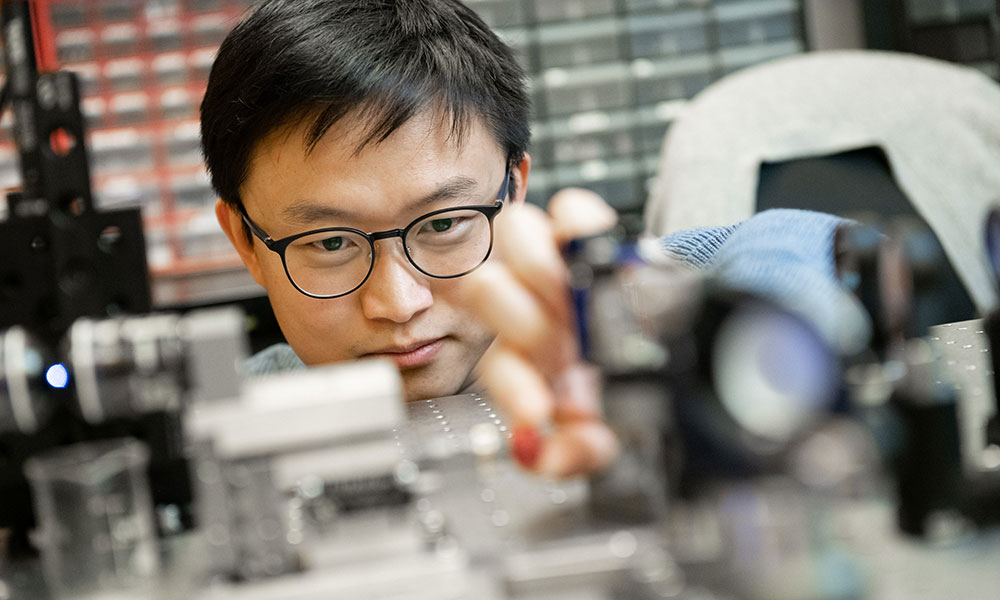
Though Dr. Li teaches chemistry, many of the questions asked by his research are biological. His work combines biology, biochemistry, biophysics, nanotechnology and bioengineering.
The impacts of visualizing cells’ physical interactions are far-reaching.
Investigating the physical touch between cells will guide a better understanding of how various diseases, including cancer, progress through the body. Eventually, Dr. Li hopes his research will lead to new strategies for treating these diseases through targeting and controlling the physical interactions.
“Often the approach is to find one molecule responsible for causing something bad and kill it,” says Dr. Li. “But biology is more complicated than that—what if we don’t kill it, but instead find it and manipulate it? Maybe it can actually help.”
He says the DNA-based tools he and his team have created to probe these processes also have the potential to enable other technologies that haven’t even been conceived.
“One hundred years ago they were studying quantum mechanics with no idea it would one day be applied to quantum computing,” says Dr. Li. “We’re advancing a body of knowledge so others can pick it up and take it from here.”
When he chose UBC Okanagan for his research, Dr. Li was drawn to the enthusiasm within his department. “I’m attracted to people and colleagues who I can collaborate with, and I think that’s what brought me here.”
In his time at UBCO, Dr. Li has found the campus’s intimate size and interdisciplinary environment allow him to easily collaborate with diverse faculty members who can benefit from his imaging methods and DNA-based tools.
Dr. Li’s research has flourished in this collaborative environment, earning him the recognition of UBC Okanagan’s 2023 Researcher of the Year for Natural Sciences and Engineering.
“I was quite humbled,” he says about his Researcher of the Year win. “I wouldn’t be here without all the support of so many people.
The post Examining single molecules for infinite possibilities appeared first on UBC Okanagan News.
